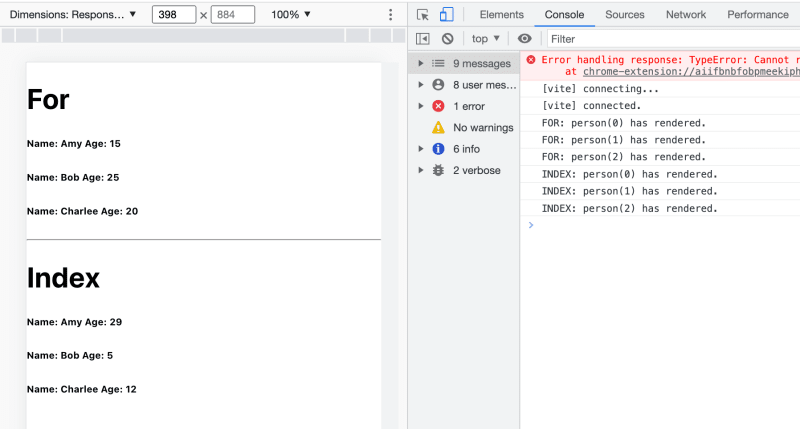SolidJS中有For和Index组件有效地渲染数组元素。 array.map效率低下,因为它总是映射整个数组。
为了
For组件是循环在一系列对象上的最佳方法。随着数组的变化,更新或移动DOM中的项目而不是重新创建它们。
指数
实心还提供了Index组件,在某些情况下会导致较少的重读者。
例如
import { For, createSignal } from "solid-js";
const initialPeople = [
{
name: "Amy",
age: 15,
},
{
name: "Bob",
age: 25,
},
{
name: "Charlee",
age: 20,
},
];
function ForComp() {
const [people, setPeople] = createSignal(initialPeople);
const changeAge = (personIdx) => () => {
const newPeople = [...people()];
newPeople[personIdx] = {
...newPeople[personIdx],
age: Math.floor(Math.random() * 30),
};
setPeople(newPeople);
};
return (
<>
<For each={people()}>
{(person, personIdx) => {
console.log(`person(${personIdx()}) has rendered.`);
return (
<div style={{ cursor: "pointer" }} onClick={changeAge(personIdx())}>
<h6>
Name: {person.name} Age: {person.age}
</h6>
</div>
);
}}
</For>
</>
);
}
function App() {
return <ForComp />;
如果单击第二项,则将像以下图像一样更改第二项的年龄。
如果您更改对象的一部分,则不会显示任何更改。
const changeAge = (personIdx) => () => {
const newPeople = [...people()];
newPeople[personIdx].age = Math.floor(Math.random() * 30);
setPeople(newPeople);
};
这是不起作用的,因为即使对象的字段已更改,对象也保持不变。
索引示例
function IndexComp() {
const [people, setPeople] = createSignal(initialPeople);
const changeAge = (personIdx) => () => {
const newPeople = [...people()];
newPeople[personIdx] = {
...newPeople[personIdx],
age: Math.floor(Math.random() * 30),
};
setPeople(newPeople);
};
return (
<>
<Index each={people()}>
{(person, personIdx) => {
console.log(`INDEX: person(${personIdx}) has rendered.`);
return (
<div style={{ cursor: "pointer" }} onClick={changeAge(personIdx)}>
<h6>
Name: {person().name} Age: {person().age}
</h6>
</div>
);
}}
</Index>
</>
);
}
function App() {
return (
<>
<h1>For</h1>
<ForComp />
<hr />
<h1>Index</h1>
<IndexComp />
</>
);
}
Index组件重新呈现当索引更改时,当For component更改其值时。
但是您仍然可以看到数据已更改,因为person()在return中使用。
return (
<>
<Index each={people()}>
{(person, personIdx) => {
console.log(`INDEX: person(${personIdx}) has rendered.`);
const p = person();
return (
<div style={{ cursor: "pointer" }} onClick={changeAge(personIdx)}>
<h6>
Name: {p.name} Age: {p.age}
</h6>
</div>
);
}}
</Index>
</>
);
如果您的人()在渲染函数中使用,则数据将不会更改。这就是SolidJS的工作方式。
添加新项目
import { For, createSignal } from "solid-js";
const initialPeople = [
{
name: "Amy",
age: 15,
},
{
name: "Bob",
age: 25,
},
{
name: "Charlee",
age: 20,
},
];
function ForComp() {
const [people, setPeople] = createSignal(initialPeople);
const changeAge = (personIdx) => () => {
const newPeople = [...people()];
newPeople[personIdx] = {
...newPeople[personIdx],
age: Math.floor(Math.random() * 30),
};
setPeople(newPeople);
};
const addNewPerson = () => {
setPeople(
people().concat({
people: "Delta",
age: 50,
})
);
};
return (
<>
<button onClick={addNewPerson}>Add New Person</button>
<For each={people()}>
{(person, personIdx) => {
console.log(`FOR: person(${personIdx()}) has rendered.`);
return (
<div style={{ cursor: "pointer" }} onClick={changeAge(personIdx())}>
<h6>
Name: {person.name} Age: {person.age}
</h6>
</div>
);
}}
</For>
</>
);
}
function IndexComp() {
const [people, setPeople] = createSignal(initialPeople);
const changeAge = (personIdx) => () => {
const newPeople = [...people()];
newPeople[personIdx] = {
...newPeople[personIdx],
age: Math.floor(Math.random() * 30),
};
setPeople(newPeople);
};
const addNewPerson = () => {
setPeople(
people().concat({
people: "Delta",
age: 50,
})
);
};
return (
<>
<button onClick={addNewPerson}>Add New Person</button>
<Index each={people()}>
{(person, personIdx) => {
console.log(`INDEX: person(${personIdx}) has rendered.`);
const p = person();
return (
<div style={{ cursor: "pointer" }} onClick={changeAge(personIdx)}>
<h6>
Name: {p.name} Age: {p.age}
</h6>
</div>
);
}}
</Index>
</>
);
}
function App() {
return (
<>
<h1>For</h1>
<ForComp />
<hr />
<h1>Index</h1>
<IndexComp />
</>
);
}
对于新项目,
都呈现新项目。结论
如果您希望数据更改不需要影响渲染,而index仅重要,那么Index将是一个不错的选择,然后For以获得更好的性能。
我希望您在本文中发现它很有用。
快乐编码!





